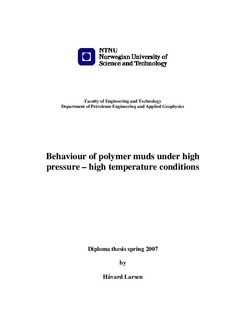| dc.contributor.author | Larsen, Håvard | nb_NO |
| dc.date.accessioned | 2014-12-19T12:14:02Z | |
| dc.date.available | 2014-12-19T12:14:02Z | |
| dc.date.created | 2007-06-12 | nb_NO |
| dc.date.issued | 2007 | nb_NO |
| dc.identifier | 122410 | nb_NO |
| dc.identifier.uri | http://hdl.handle.net/11250/239268 | |
| dc.description.abstract | A well is classified as a HPHT (High Pressure High Temperature) well if the static bottomhole temperatures are greater than 350 °C and when the formation pressures exceed 1800 kg/m3 ECD. Mud weights as high as 2400 kg/m3 may be required to maintain a proper well control. The temperature of the drilling fluid when circulating in the well may range from 0 °C to 150 °C and it is important that the drilling fluid maintain acceptable rheological properties within the whole range. The rheological properties of the mud will strongly depend on the temperature and the pressure variations. The problems regarding HPHT wells are mostly due to ECD and cuttings transport.
In order to control and measure the viscosity for deep HPHT wells we have conducted laboratory experiments that deal with aging at different temperatures on a polymer mud, as well as pressure and temperature effects on a field mud. We have also calculated the annular pressure using Landmark Wellplan software. To calibrate the instruments, i.e. the Physica HPHT viscometer and a Fann viscometer, we used ubelohde, known to give an exact value of the viscosity of a fluid. The calibration liquid was a 2-stroke motor oil with different amounts of Exxsol-D60 added.
The aging experiments were conducted in a mixture of water and HEC that were put in three different incubators at 20 °C, 60 °C and 90 °C for 1, 3, 8, 11, 15 and 20 days. The results showed that the viscosity decreased rapidly in the solutions that were aged at the highest temperatures and that most of the decrease took place during the first day of aging.
In the experiments on real (field) mud exposed to high pressures and temperatures the Physica viscometer was used. The results showed that the pressure effects were negligible compared to the temperature effects. During the measurements we experienced that the viscosity decreased as the temperature increased and that the decrease in the viscosity was more significant from 20 to 60 °C than from 60 to 90 °C.
Based on the results obtained in the laboratory and an evaluation of fluid implication on well pressure, we were able to draw the following main conclusions:
• Laboratory experiments are very educational. To learn that reality is not straight forward to measure was enlightening.
• The viscosity is very dependant on the temperature.
• The combined effect of pressure on the viscosity of a field mud is negligible.
• The annular pressure differences calculated in Landmark Wellplan did not show any significant differences for the different well temperatures. | nb_NO |
| dc.language | eng | nb_NO |
| dc.publisher | Institutt for petroleumsteknologi og anvendt geofysikk | nb_NO |
| dc.title | Behaviour of polymer muds under high pressure – high temperature conditions | nb_NO |
| dc.type | Master thesis | nb_NO |
| dc.contributor.department | Norges teknisk-naturvitenskapelige universitet, Fakultet for ingeniørvitenskap og teknologi, Institutt for petroleumsteknologi og anvendt geofysikk | nb_NO |
